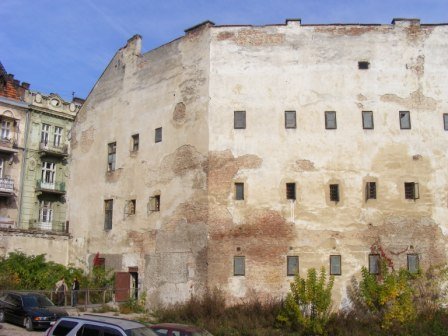
Visiting the Prison on Łącki Street, Lviv, Ukraine: Visiting Hours, Tickets, and Historical Significance
Date: 14/06/2025
Introduction: The Enduring Legacy of the Prison on Łącki Street
Nestled in central Lviv, the Prison on Łącki Street stands as one of Ukraine’s most significant sites of memory. Constructed in the late 19th century, this Neo-Renaissance building has borne witness to the city’s turbulent history—serving as a detention center under Austro-Hungarian, Polish, Soviet, and Nazi German regimes. Today, as the National Museum-Memorial of Victims of Occupation Regimes, it offers visitors an immersive exploration of Lviv’s complex past, commemorating those who suffered within its walls and illuminating the broader narratives of repression and resilience that have shaped the region.
Table of Contents
Historical Overview
Austro-Hungarian Foundations (1889–1890)
The Prison on Łącki Street was constructed between 1889 and 1890 as the main office of the Austro-Hungarian Gendarmerie, designed by architect Józef Kajetan Janowski. The building’s Neo-Renaissance facade and robust structure reflected the priorities of law enforcement and security in the empire. Initially not intended as a prison, its design nevertheless set the stage for its later uses under successive regimes (Wikipedia, Euromaidan Press).
Transformation under Polish Administration (1918–1939)
Following the collapse of the Austro-Hungarian Empire after World War I, Lviv became part of the Second Polish Republic. Between 1918 and 1920, the building was expanded into a prison, serving as a detention center for political prisoners—most notably members of Ukrainian nationalist and communist movements. During the interwar period, the prison became notorious for harsh conditions, symbolizing both state authority and repression (Euromaidan Press, mywanderlust.pl, academia.edu).
Soviet and Nazi Occupation (1939–1944)
With the Soviet occupation of Lviv in 1939, the NKVD (Soviet secret police) took over the prison, using it to detain, interrogate, and execute suspected Ukrainian nationalists, Polish intelligentsia, and others. In June 1941, as the Soviets retreated before advancing Nazi forces, mass executions of prisoners took place—an atrocity commemorated in the museum’s exhibitions (Wikipedia, lviv.travel, karpaty.info). Under Nazi occupation, the prison was repurposed as a Gestapo detention center, with further acts of repression and violence. Postwar, the building continued to serve as a site of Soviet state security operations until Ukraine’s independence.
Architectural Features
The prison is a striking example of Neo-Renaissance architecture. Its symmetrical facades, arched windows, and classical details offer a visual counterpoint to its somber history. The three-story complex includes:
- Original cells (single and communal)
- Interrogation rooms and investigator offices
- Courtyard (historically used for exercise and executions)
- Basement dungeons for solitary confinement
Security features—thick masonry walls, iron-barred windows, and reinforced doors—were enhanced by each regime to meet evolving demands (Lviv Travel, Atlas Obscura, Karpaty.info).
Visitor Information
Hours, Tickets, and Tours
- Opening Hours: Tuesday to Sunday, 10:00 AM – 6:00 PM; closed Mondays and major public holidays.
- Admission: Adults – 50 UAH; Students/Seniors – 30 UAH; Children under 7 – free.
- Guided Tours: Available in Ukrainian and English with advance booking; audio guides in multiple languages can be rented on-site.
- Special Exhibitions: Regularly scheduled commemorative events and temporary exhibitions; check the official website for updates (official museum website, lviv.travel).
Accessibility and Location
- Address: 1 Karla Bryullova Street (formerly Łącki Street), Lviv, Ukraine.
- Getting There: Central location, walkable from Lviv Old Town; accessible via tram and bus (nearest stop: Stepana Bandery Street).
- Accessibility: Main exhibition areas are wheelchair accessible; some historic sections (basement cells) may have limited access.
Nearby Attractions
Enhance your itinerary with visits to:
- Lviv Opera House (1.5 km)
- Market Square (Rynok Square) (1.8 km)
- Armenian Cathedral
- Museum of the History of Religion
Photography and Visual Resources
- Photography: Permitted in most areas (no flash or tripods in sensitive zones); high-quality images and virtual tours available on the museum website.
- Interactive Map: Embedded maps and markers for easy navigation.
FAQs
Q: Are tickets available online?
A: Yes, tickets can be purchased on-site or via the museum’s official website. Advance booking is recommended for guided tours.
Q: Is the museum suitable for children?
A: Some exhibitions contain sensitive content; parental discretion is advised.
Q: How long does a typical visit take?
A: 1.5 to 2 hours is recommended for a thorough visit.
Q: Are there audio guides or tours in English?
A: Yes, audio guides and English-language tours are available with prior arrangement.
Q: Is the museum accessible for those with limited mobility?
A: Most main areas are accessible; inquire in advance for specific needs.
Conclusion
The Prison on Łącki Street stands as a powerful symbol of Lviv’s endurance through periods of occupation, repression, and change. Today, as a museum and memorial, it invites visitors to reflect on the tragedies of the past—and the resilience of those who endured them. Whether you are a historian, student, or traveler, your visit will deepen your understanding of Lviv’s layered heritage. Plan ahead, consider a guided tour, and explore nearby landmarks for a comprehensive experience.
For the latest information on tickets, events, and accessibility, consult the official museum website and Lviv Travel.
References
- Euromaidan Press
- Lviv Travel
- Wikipedia – Prison on Łącki Street
- mywanderlust.pl
- Official Museum Website
- NKVD prisoner massacres in Lviv – Wikipedia
- Karpaty.info
- Atlas Obscura
- Rare Historical Photos
- Audiala App


































